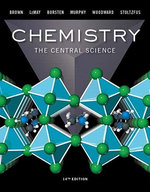?The compound \(\mathrm{XCl}_{4}\) contains 75.0 % CI by mass. What is the element X?
Chapter 3, Problem 3.50(choose chapter or problem)
The compound \(\mathrm{XCl}_{4}\) contains 75.0 % CI by mass. What is the element X?
Text Transcription:
XCl4
Unfortunately, we don't have that question answered yet. But you can get it answered in just 5 hours by Logging in or Becoming a subscriber.
Becoming a subscriber
Or look for another answer
